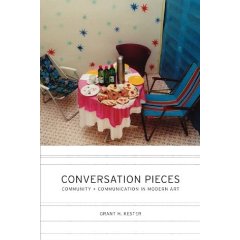Social Practice
Writings about the social in contemporary art
Privileging Context over Aesthetics
I’m going to try my best to keep these posts a little shorter, but these concepts do not coalesce in my head very easily or in a very fully baked form, so I find myself having to really write through them. Also, I am not exactly the most concise of writers. So, thanks for bearing with me.
I would like to return to my discussion of theoretical frameworks that have been used to analyze socially-engaged artworks (oh, what a difficult term…isn’t all art rife with the social? But I hope you know what I’m talking about by now), as in my previous post on relational aesthetics. In that post, I pointed out that Bourriard’s discussion of relational aesthetics as a “theory of form” just didn’t quite do justice to the social, spatial, and political dimensions of this work. Grant Kester, in his book “Conversation Pieces: Community and Communication in Modern Art” gets a little closer to laying out the various layers of social practice, what he terms as “dialogical aesthetics” (another relatively useless term - shoehorning these practices into some qualified type of aesthetics still seems so reductive to me). Kester manages not only to link these practices quite cogently to an art historical lineage, but also to begin to think about a more rounded framework for approaching them critically. Which is why his book, even after 10 years, is still the undisputed central text concerning community-based and socially-engaged artworks.

Grant Kester, Conversation Pieces
Kester begins the chapter in which he lays out his analytic framework by talking about conceptual art not only as a move away from the purely visual, but as a robust set of concerns extending beyond (but not entirely rejecting) the art object itself. He says of conceptual artists like Adrian Piper, Vito Acconci and Felix Gonzalez-Torres: “They tend to focus on ways in which the optical experience is conditioned by a given social context or physical situation and by the viewer’s participation.” Seedbed, Acconci’s iconic performance in January of 1971 at Sonnabend in New York, is cited as an example - the viewer must be present to complete the piece, as the interaction between the masturbating artist under the floor and the unaware, disgusted or curious viewer was central to the piece.

Vito Acconci, Seedbed, January 15-29, 1971, New York City
I like this little concise description of conceptual practice from this era, because it throws into relief the different territories we are dealing with in art: optical experience, social or physical context, and viewer participation. It also provides a useful model for distinguishing social practice: in my view, social practice takes the work of conceptualism and twists it to privilege the context over all else. To switch around Kester’s description accordingly, I would say that social practice artists are concerned with the way a given social context or physical situation (usually both) is conditioned by optical experience (or aesthetic exchange) and viewer/creator/stakeholder interaction.
Accordingly to Kester, how successfully an artist enacts this analysis and practicing of the social can be broken into a three-part theoretical framework. He takes John Latham and Barbara Steveni’s Artist Placement Group as the trigger for his first two parts: 1) a project should first be examined by its ability to define art as a “condition of openness.” Does the artist seize the opportunity to approach a problem “unconventionally, naively, open-mindedly, as if from the outside?” He does note, however, that the tolerance for this kind of problem-solving practice drops quickly when applied outside of the art world, as in APG. Secondly, he examines a project in terms of its “critical time-sense.” Is the artist thinking in very long terms, about the “viewer-to-be” and about communities that are not yet emergent? Is the artist also thinking backwards in time, with a historical time-sense? He links this with what he calls a “spatial imagination,” the ability to “comprehend and represent complex social and environmental systems, identify interconnections among the often invisible forces that pattern human and environmental existence.” Finally, Kester ends with an analysis of the ability of the artist/project to “enact these insights through dialogical and collaborative encounters with others.”
I do think that this framework hits upon three major reasons for why an artist might be an appropriate “incidental person,” someone equipped to confront larger societal problems: 1) the ability to approach a problem naively and with a condition of openness; 2) a longer critical “time-sense,” beyond the short-term thinking dictated by certain disciplines (i.e. the market, quarterly, in election cycles, in fiscal years, etc); 3) a spatial imagination as defined above.
Yet the enactment of these artistic insights is where we fall down. Relational aesthetics, dialogical aesthetics, conversations and beer drinking and making food for each other…it all feels very 1990s. Form evolves, as I said before. What are things like these day? Well, Mark Allen from Machine Project took over LACMA for a day and will be taking over Visitor Services at the Hammer Museum for a full year. Edgar Arceneaux is renovating houses down in Watts and conducting job-training in green technologies. The LA Urban Rangers are giving tours of public access beaches in Malibu and holding public easement potlucks. And that’s just a few…

LA Urban Rangers, Malibu Beach Safari
How do we approach such projects critically? Do we measure their effects, conduct surveys, link their forms to previous art historical models, interview the artists for some insight into their conceptual rigor? It is fraught territory indeed.
Eating, Drinking, and Making Merry
One of the issues with art that is inherently based on social exchange is that these practices have not really been clearly examined or theorized. There is a tendency amongst art writers and curators and artists to smush together all kinds of varied “movements” like Dada, Fluxus, the Situationists, Happenings, relational aesthetics (a la Bourriard), and dialogical aesthetics (a la Kester). Not to mention the fact that a variety of very vague terms are used to describe these practices (community art, public practice, social practice, etc). I have found myself falling into this lazy naming, but I feel that I must start somewhere. Very simply, the language has not been adequately defined, and I hope to work through some of these terms in my posts.
So what exactly am I talking about? Perhaps some of the definitions of writers I look to frequently in my studies of these practices will help map out this fraught territory, and an iterative study of particular projects will help to illustrate the context. We’ll start with Nicholas Bourriard. The term he coined, “relational aesthetics,” now elicits snorts and scoffs, and has come to stand for a post-critical art of “congeniality,” a realm in which a bunch of lazy artists have learned that they can call dinner parties and beer-drinking “artworks” within a gallery or museum setting. “Found” parties rather than objects, injected without much thought or rigor into art historical discourse.

Free Beer - Tom Marioni
I believe, however, that Bourriard was getting at something that has since been colloquially lost in translation - some (but not all) of the art he talks about hits on questions of community, societal mores, the meaning of public space, and how economies or technologies shape day-to-day social interaction. This is interesting, but the “theory of Form” that Bourriard advances lumps these practices with those that concern themselves only with the social networks of the art world and pleasurable congeniality. This is problematic, and does a disservice to the works that are critically examining political and cultural contexts. The metric he advances is simply not adequate to make those distinctions.
Relational Aesthetics
Bourriard calls relational aesthetics a “theory of form” in his series of essays on art from the 1990s. He traces this in the historical trajectory of the avant-garde, positing that the “perceptive, experimental, critical, and participatory” models of current art are carrying on the “modernist fight,” albeit in the context of quite different societal presuppositions. He defines relational art as “an art taking as its theoretical horizon the realm of human interactions and its social context, rather than the assertion of an independent and private symbolic space.” These artworks examine social systems, and turn small exchanges into issues reflective of a broader society shaped by political, economic, and social mores. He calls the “arena of encounter” created by these works “a game” - in which participatory structures are modeled. He believes that this “arena” must be judged by its coherence of form, the symbolic value of the “world” it suggests to us, and the image of human relations reflected by it.

Rirkrit Tiravanija, Exhibition View, Secession 2002
Some of the works Bourriard describes include:
“Rikrit Tiravanija organizes a dinner in a collector’s home, and leaves him all the ingredients required to make a Thai soup.”
“Philippe Pareno invites a few people to pursue their favorite hobbies on May Day, on a factory assembly line.”
“Vanessa Beecroft dresses some twenty women in the same way, complete with a red wig, and the visitor merely gets a glimpse of them through the doorway.”
“Christine Hill works as a check-out assistant in a supermarket, organizes a weekly gym workshop in a gallery.”
“Pierre Huyghe summons people to a casting session, makes a TV transmitter available to the public, and puts a photograph of laborers at work on view just a few yards from the building site.”
We could add people like Liam Gillick, Adrian Piper, Tom Marioni, Felix Gonzalez-Torres, and Jens Haaning to this list according to Bourriard’s rubric - but I still feel uncomfortable lumping the practices of these artists together. Perhaps they are all part of some broader contemporary trajectory, but they each are concerned with such different realms of interaction. Relational aesthetics is a good start, a useful entry into these practices, but is just too reductive in its language. Rigorous social practice rarely begins and ends with friendly interactivity between an artist and a public. We are beyond relational aesthetics as a theory of form, because the form keeps changing and evolving. What we need is a deeper analysis of how artists are inserting themselves into realms that have never traditionally been spaces for art.